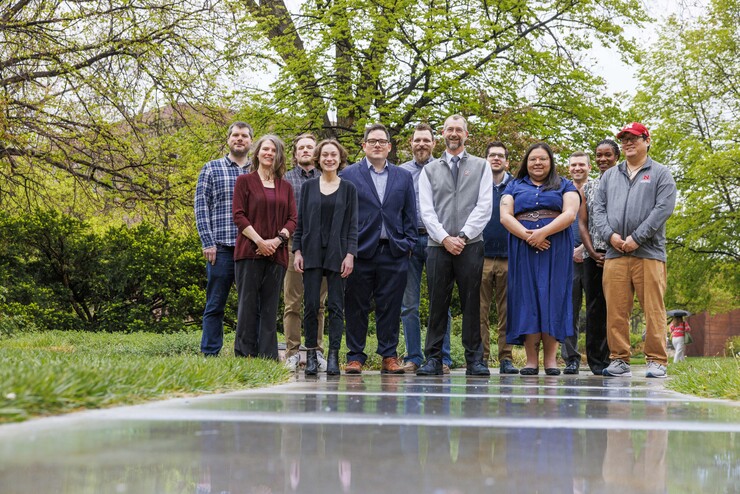· 5 min read
Rural Drug Addiction Research Center renewed for five more years

Five years of initial research has given the Rural Drug Addiction Research Center a strong foundation, and its next phase will focus on building partnerships with communities across Nebraska.
The center, founded at the University of Nebraska–Lincoln in 2019, received an $11,597,682 Phase 2 renewal grant from the National Institutes of Health’s Centers of Biomedical Research Excellence Program, known as COBRE, to continue its work through 2029.
“We have a better understanding of some of the issues, needs and concerns that our constituents are having,” said Rick Bevins, principal investigator and center director.
The center’s mission is to advance understanding of causes, impacts and interventions related to rural drug use and misuse in the Midwest, a geographic area that has been historically understudied. Designed to be interdisciplinary and data-driven, the center links pre-clinical studies to field-based behavioral, neural, social, clinical and translational research and dissemination.
The first five years have been eye-opening for researchers.
“We’ve known for a very long time that drug use and misuse has been a major issue in rural communities,” said Bevins, Mildred Francis Thompson Professor of psychology and associate vice chancellor for research. “Past research has focused heavily on the urban communities, with maybe an underlying assumption that whatever we learn there will be applicable to rural areas.
“It turns out that’s not the case.”
Among the unique challenges in rural America: The stigma of substance misuse can be greater in an environment where there can be less anonymity, Bevins said.
“On a Wednesday evening, if you’re parked out in front of the AA or NA meeting place in one of our smaller communities around the state, folks passing by may assume you’re there for the meeting. Much less privacy,” Bevins said.
Researchers also have a better understanding of the nature of the drug issues in rural Nebraska than they did five years ago. While opioids get much of the attention now — and certainly are present in the state — methamphetamine is far more prevalent.
“We are squarely in a meth crisis,” Bevins said.
Even within meth use, he said, there are differences in how the drug is used in different parts of the region.
Kimberly Tyler, co-director of the center’s Longitudinal Networks Core, who focuses on hidden or hard-to-reach populations, said the center’s research also found significant links between homelessness and substance misuse. One of the core’s pilot studies found that women in rural areas were using drugs more frequently than researchers expected, and little research has focused specifically on them, said Tyler, George Holmes University Professor of sociology.
The Rural Drug Addiction Research Center’s past and current studies have focused on a breadth of topics, such as:
- Predictors of sex-linked marijuana and alcohol use in sexual minority women.
- The links between interpersonal conflict and drug use in the Great Plains.
- Understanding pathways and access to opioid agonist treatment in Nebraska.
- Neurocognitive assessments of individuals who use drugs.
- The relationship between violence and substance use.
- Sex-specific cellular markers associated with chronic methamphetamine use.
- Substance misuse among college students with ADHD and its relationship to educational outcomes.
- Knowledge and beliefs about drug use and naloxone among the general public in Nebraska.
Devan Crawford, center coordinator, said the center’s Phase 1 funding created a strong infrastructure by building a unique research core, providing targeted grant development and mentoring resources, and building teams of interdisciplinary researchers who might never have considered conducting substance use focused studies without the center’s support.
“The runway is quite long,” she said. “Now we’re to a place of sharing some of our initial research findings with communities. Most importantly, how do we benefit from communities’ perspectives on that information? How do we learn from communities what their scientific questions are … and how can we incorporate those questions and community priorities into the next five to 10 years of center research?”
To that end, the center will work with Nebraska Extension and Rural Prosperity Nebraska.
“This is very much a community-engaged approach,” Bevins said.
In addition to advancing the science behind drug use and misuse, the center hopes to change community perceptions.
“We need to make inroads on decreasing stigma, because stigma in my opinion is the No. 1 barrier to getting supports and healing,” Bevins said.
Tyler added that the center’s recently published article using the Nebraska Annual Social Indicators Survey found that holding more stigmatized attitudes about substance use is associated with support for legal system responses, while holding less stigmatized attitudes about certain drugs is associated with support for public health solutions.
The center works closely with all University of Nebraska campuses, especially the University of Nebraska Medical Center, to increase its reach and impact. It is one of three Centers of Biomedical Research Excellence at UNL.
Research reported in this news release was supported by the National Institute of General Medical Sciences of the National Institutes of Health under award number P20GM130461.The content is solely the responsibility of the authors and does not necessarily represent the official views of the National Institutes of Health.








